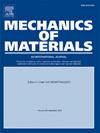Effects of grain orientation and confinement on dynamic compressive behavior of highly oriented MAX phase Ta2AlC
IF 3.4
3区 材料科学
Q2 MATERIALS SCIENCE, MULTIDISCIPLINARY
引用次数: 0
Abstract
MAX phases are unique ternary carbides and nitrides that bridge the gap between metals and ceramics. Specifically, Ta2AlC, the MAX phase with the highest bulk modulus, offers a unique combination of metallic and ceramic properties, making it particularly well-suited for extreme applications. Fully dense, coarse-grained, and textured Ta2AlC was fabricated in bulk, achieving a global grain orientation along the c-axis with an orientation factor of 0.63. The uniaxial quasi-static and dynamic, and biaxial dynamic response was evaluated parallel () and perpendicular (⊥) to the c-axis. The average dynamic strength in ⊥ c-axis orientation was 824 ± 39 MPa, 19 % higher than the uniaxial quasi-static compressive strength of 690 ± 55 MPa in the same orientation. The biaxial dynamic strength in this orientation, when applying a moderate 80 MPa planar confinement along basal planes ( c-axis) had the highest average compressive strength of 1097 ± 72 MPa. Scanning electron microscopy fractography indicates a consistent fracture mechanism within the grain orientation across different strain rates under uniaxial loading. During biaxial loading, crack propagation was delayed, with qualitative indications of shear band formation. Concurrently, both the quantity and mode of kink band formation appeared to increase, leading to an overall enhancement in final strength. The link between macroscopic failure behavior captured from ultra-high-speed imaging and microscopic fractography is discussed.
晶粒取向和约束对高取向MAX相Ta2AlC动态压缩行为的影响
MAX相是独特的三元碳化物和氮化物,弥合了金属和陶瓷之间的差距。具体来说,Ta2AlC,具有最高体积模量的MAX相,提供了独特的金属和陶瓷性能组合,使其特别适合极端应用。制备了致密、粗晶和织构的Ta2AlC,实现了沿c轴的全局晶粒取向,取向因子为0.63。对与c轴平行(∥)和垂直(⊥)的单轴准静态和动态以及双轴动态响应进行评估。c轴方向的平均动态强度为824±39 MPa,比同一方向的单轴准静态抗压强度690±55 MPa高19%。当沿基面(⊥∥c轴)施加中等80 MPa的平面约束时,这个方向的双轴动态强度最高,平均抗压强度为1097±72 MPa。扫描电镜断口形貌显示,在单轴载荷作用下,不同应变速率下晶粒取向内的断裂机制一致。在双轴加载过程中,裂纹扩展被延迟,并有剪切带形成的定性迹象。同时,扭结带形成的数量和方式都有所增加,导致最终强度的整体提高。讨论了超高速成像捕获的宏观破坏行为与微观断口学之间的联系。
本文章由计算机程序翻译,如有差异,请以英文原文为准。
求助全文
约1分钟内获得全文
求助全文
来源期刊

Mechanics of Materials
工程技术-材料科学:综合
CiteScore
7.60
自引率
5.10%
发文量
243
审稿时长
46 days
期刊介绍:
Mechanics of Materials is a forum for original scientific research on the flow, fracture, and general constitutive behavior of geophysical, geotechnical and technological materials, with balanced coverage of advanced technological and natural materials, with balanced coverage of theoretical, experimental, and field investigations. Of special concern are macroscopic predictions based on microscopic models, identification of microscopic structures from limited overall macroscopic data, experimental and field results that lead to fundamental understanding of the behavior of materials, and coordinated experimental and analytical investigations that culminate in theories with predictive quality.
 求助内容:
求助内容: 应助结果提醒方式:
应助结果提醒方式:


